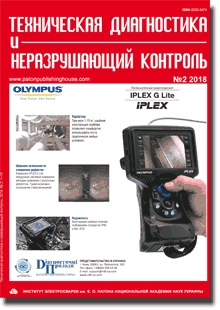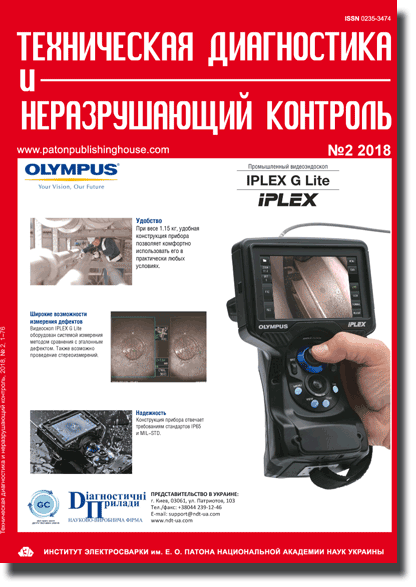| 2018 №02 (10) |
DOI of Article 10.15407/tdnk2018.02.01 |
2018 №02 (02) |

Technical Diagnostics and Non-Destructive Testing №2, 2018, pp. 3-15
Results of studying the causes for cracking in titanium alloy blades of steam turbines of K-1000-60/3000 TYPE
V.M. Torop1, O.V. Makhnenko1, G.Yu. Saprykina1, E.E. Gopkalo2
1 E.O.Paton Electric Welding Institute of the NAS of Ukraine, 11 Kazimir Malevich str., 03150, Kiev. E-mail: office@paton.kiev.ua
2 G.S.Pisarenko Institute for Problems of Strength of the NAS of Ukraine, 2 Timiryazevskaya str., 01014, Kyiv, Ukraine. E-mail: info@ipp.kiev.ua
Abstract:
The paper presents the results of studying the causes for cracking in blades of the last stage of steam turbines K-1000-60/3000, operating in Ukrainian NPP. The main causes, physical essence of formation and accumulation of erosion damage of blade material surface as a result of high-velocity drop impact of overcooled steam still remain insufficiently studied. During performance of the work, a comprehensive study of the structure, chemical composition and mechanical properties of blade material was conducted. Morphological and fractographic investigations of the crack surface were performed. Proceeding from the results of these studies, conclusions were formulated on the causes of defects and the possibility of prediction of the residual life of blades. 9 References, 3 Tables, 23 Figures.
Keywords: erosion damage, cracks, steam turbine blade, morphological and fractographic studies, chemical composition, mechanical properties, titanium alloy TS5
- Kostyuk, A.G. (2007) Dynamics and strength of turbomachines. Moscow, Izd. Dom MEI [in Russian].
- Dejch, M.E., Filipov, G.A. (1987) Two-phase flaws in components of thermal power generation equipment. Moscow, Energoatomizdat [in Russian].
- Lanina, A.A. (2009) Features of structural and phase transformations in titanium blades of steam turbines during drop-impact effect. In. Syn. of Thesis for Cand. of Techn. Sci. Degree. St.-Petersburg [in Russian].
- Krylov, N.A., Skotnikova, M.A., Tsvetkova, G.V., Ivanova, G.V. (2016) Influence of the structure and phase composition of the material of steam turbine blades from a titanium alloy on their resistance to erosion fracture. Nauchno-Tekhnicheskie Vedomosti St.-PPU. Estestvennye i Inzhenernye Nauki, 3(249), 86-92 [in Russian].
- Bilous, V.A., Voevodin, V.M., Khoroshikh, V.M. et al. (2016) Development of experimental equipment and basic technics for producing cavitation-resistant protective coatings on working surfaces of steam turbine blades from titanium alloy VT-6 with a purpose of substitution of import of similar products. Nauka ta Innovatsii, 12(4), 29-39 [in Ukrainian].
- Kanel, G.I., Razorenov, S.V., Utkin, A.V., Fortov, V.E. (1996) Shock-wave phenomena in condensed media. Moscow, Yanus-K [in Russian].
- TU 1-5-130-78 (1978): Rods rolled and forged from titanium alloy. Grade TS5 [in Russian].
- GOST 1497-84 (1984): Metals. Tensile testing methods [in Russian].
- GOST 25502-79 (1981): Strength analysis and testing in mechanical engineering. Methods of mechanical testing of metals. Methods of fatigue testing [in Russian].
Received: 20.02.2018
Published: 24.05.2018
The cost of subscription/purchase order journals or individual articles
| Journal/Currency | Annual Set | 1 issue printed |
1 issue |
one article |
| TPWJ/USD | 384 $ | 32 $ | 26 $ | 13 $ |
| TPWJ/EUR | 348 € | 29 € | 24 € | 12 € |
| TPWJ/UAH | 7200 UAH | 600 UAH | 600 UAH | 280 UAH |
| AS/UAH | 1800 UAH | 300 UAH | 300 UAH | 150 UAH |
| AS/USD | 192 $ | 32 $ | 26 $ | 13 $ |
| AS/EUR | 180 € | 30 € | 25 € | 12 € |
| SEM/UAH | 1200 UAH | 300 UAH | 300 UAH | 150 UAH |
| SEM/USD | 128 $ | 32 $ | 26 $ | 13 $ |
| SEM/EUR | 120 € | 30 € | 25 € | 12 € |
| TDNK/UAH | 1200 UAH | 300 UAH | 300 UAH | 150 UAH |
| TDNK/USD | 128 $ | 32 $ | 26 $ | 13 $ |
| TDNK/EUR | 120 € | 30 € | 25 € | 15 € |
AS = «Automatic Welding» - 6 issues per year;
TPWJ = «PATON WELDING JOURNAL» - 12 issues per year;
SEM = «Electrometallurgy Today» - 4 issues per year;
TDNK = «Technical Diagnostics and Non-Destructive Testing» - 4 issues per year.





